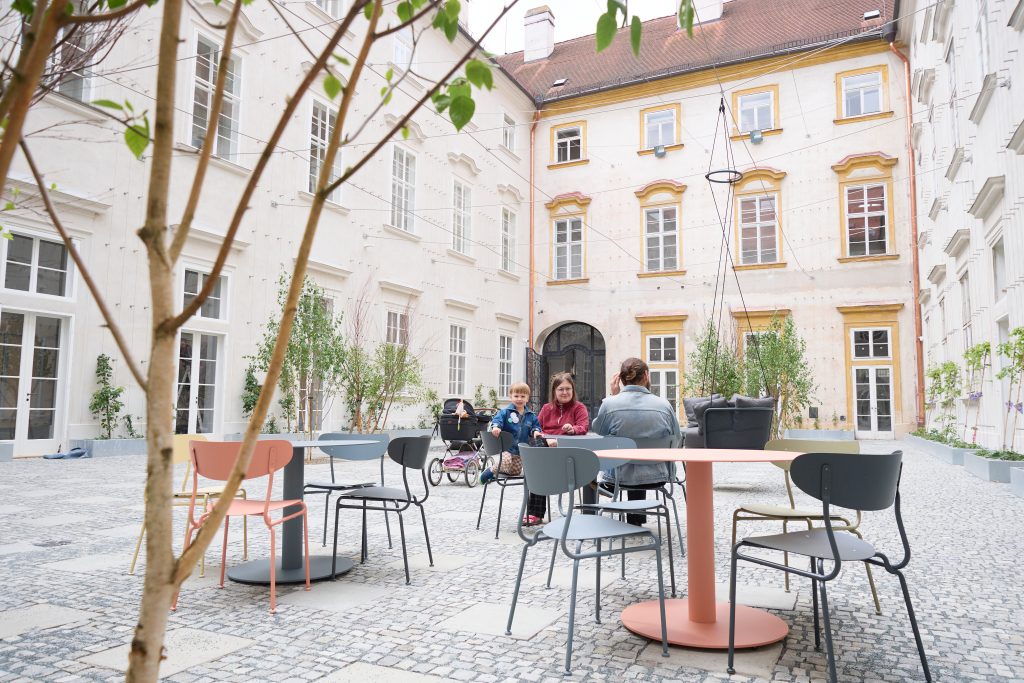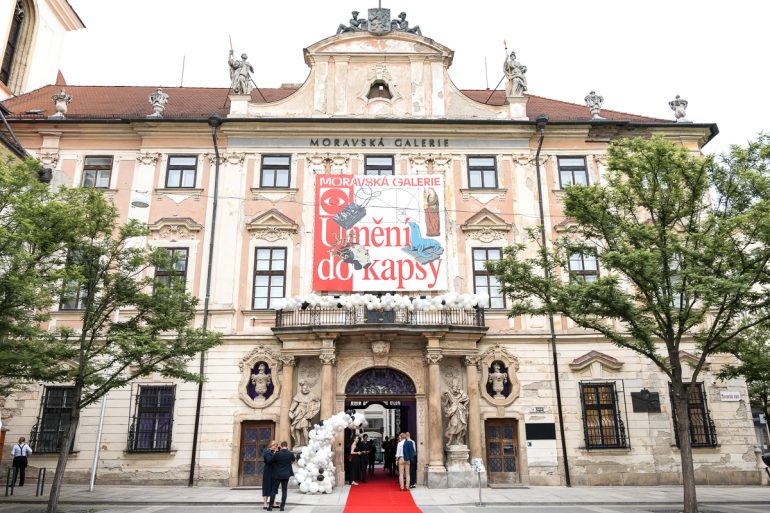Last week on 1 June, there was a partial reopening of the Moravian Gallery in the Governor’s Palace, which is undergoing a massive renovation that will still last some years.
The ground floor and the courtyard are now open again, and are hosting a new permanent exhibition called ‘Art in the pocket’ (Umění do kapsy), along with a bookshop and outdoor seating in a green area.
Access for those with low mobility is also available from Běhounská.
“After more than 20 years of obtaining financial support, we managed to start the reconstruction of the Governor’s Palace, whose first phase we started last year and have now completed,” said Jan Press, director of the Moravian Gallery. “The bookshop has also been renovated, and visitors can also buy products from the Květná glass factory, which is operating again.”
The reconstruction was co-financed from the European Union IROP funds, with further financial support of around CZK 36 million provided by the Czech Ministry of Culture.
The new permanent exhibition is intended to serve as a guide to the world of art, aiming to broaden horizons and strengthen the ability to appreciate and understand art. It was prepared by the museum’s teaching department, in cooperation with the chief curator of the gallery Ondřej Chrobák.
“When preparing the exhibition, we were inspired by the small pocket encyclopaedia ‘Mind in the pocket’ (Rozum do kapsy) – the exhibition’s title is also derived from this,” explained Michaela Gerichová, one of the exhibition’s authors. “The rooms are divided into individual chapters and the exhibits themselves become their pictorial annex. The exhibition also includes a name index. We tried to create a kind of guide to the art world suitable for both beginners and advanced artists.”
The exhibition’s six chapters highlight mankind, and the things that directly affect and indirectly surround it.

The first of them symbolically deals with time conceived linearly, limited only by beginning and end. The Man and Time room is meant as a chronology of a person from birth to death, but also a timeline of the creation of art. The second chapter Man–Landscape or Man–Nature represents an age-old dialogue, full of entry, intervention, observation and mutual coexistence.
The third chapter deals with the relationship between man and technology, narrowing down to the phenomenon of the gradual loss – or perhaps voluntary transfer – of the artist’s control over work now in the hands of technology. In the next room, Man and Man, visitors will find a completely different aesthetic experience of art, being able to touch the artwork with a mask on their eyes.
Featuring a collection of works of art for blind and partially sighted visitors, 36 works of different shapes, sizes, materials, and methods of interaction will be displayed, created by 20 contemporary artists.
The fifth chapter is Man and Ugliness, which deals with traps, violence and fear. This will include one of the most famous pieces of art belonging to the Moravian Gallery, the Medusa painting by Peter Paul Rubens from 1618. The last chapter, entitled Man and Holidays, deals with the theme of time perceived cyclically, as a circular succession of customs, traditions and holidays.
Integral to the exhibition are the information panels with concept cards, which will explain or refresh concepts from the history of visual arts.
“We have always tried to conceive the ‘Art in the pocket’ exhibition as a user-friendly fine art exhibition. Our goal was that everyone, regardless of their level of art knowledge, would be able to navigate the exhibition and have a holistic aesthetic experience from the presented works,” added Robert Spurný, one of the exhibition’s authors.
The architectural studio CHYBIK + KRISTOF has been overseeing the reconstruction.
In the courtyard, original materials were employed to preserve the large-format paving. The space was further complemented by large flower pots for climbing plants and a trio of green islands with trees.

Ondřej Chybík from the CHYBIK + KRISTOF studio added: “The outdoor furniture is chosen from Czech manufacturers (the companies Todus and mmcité) and its surprising colour is derived by analogy from the colour spectrum of the painting above the altar in the adjacent church of St. Thomas. Historically, the area was one whole, and this conceptual decision conceptually connects the two buildings into one complex again.”
Monochromatic surfaces were chosen for the exhibition spaces, which are intended to serve as a clean background for displaying works of art. The white painting here is complemented by white terrazzo on the floor and white door fittings. A new visual connection has also been established between the foyer of the Baroque Hall and the exhibition itself, which compositionally follows the already existing enfilade in the exhibition spaces.
The new accessible entrance to the building from Běhounská is the most important part of this stage of the reconstruction, enablling the separation of the function of the hall and the gallery itself. At the same time, it brings the gallery closer to the city centre. Through the transparent door, people will be able to see inside from Jakubska náměstí.
The gallery is open from Wednesday to Sunday from 10am to 6pm, or until 7pm on Thursdays.






